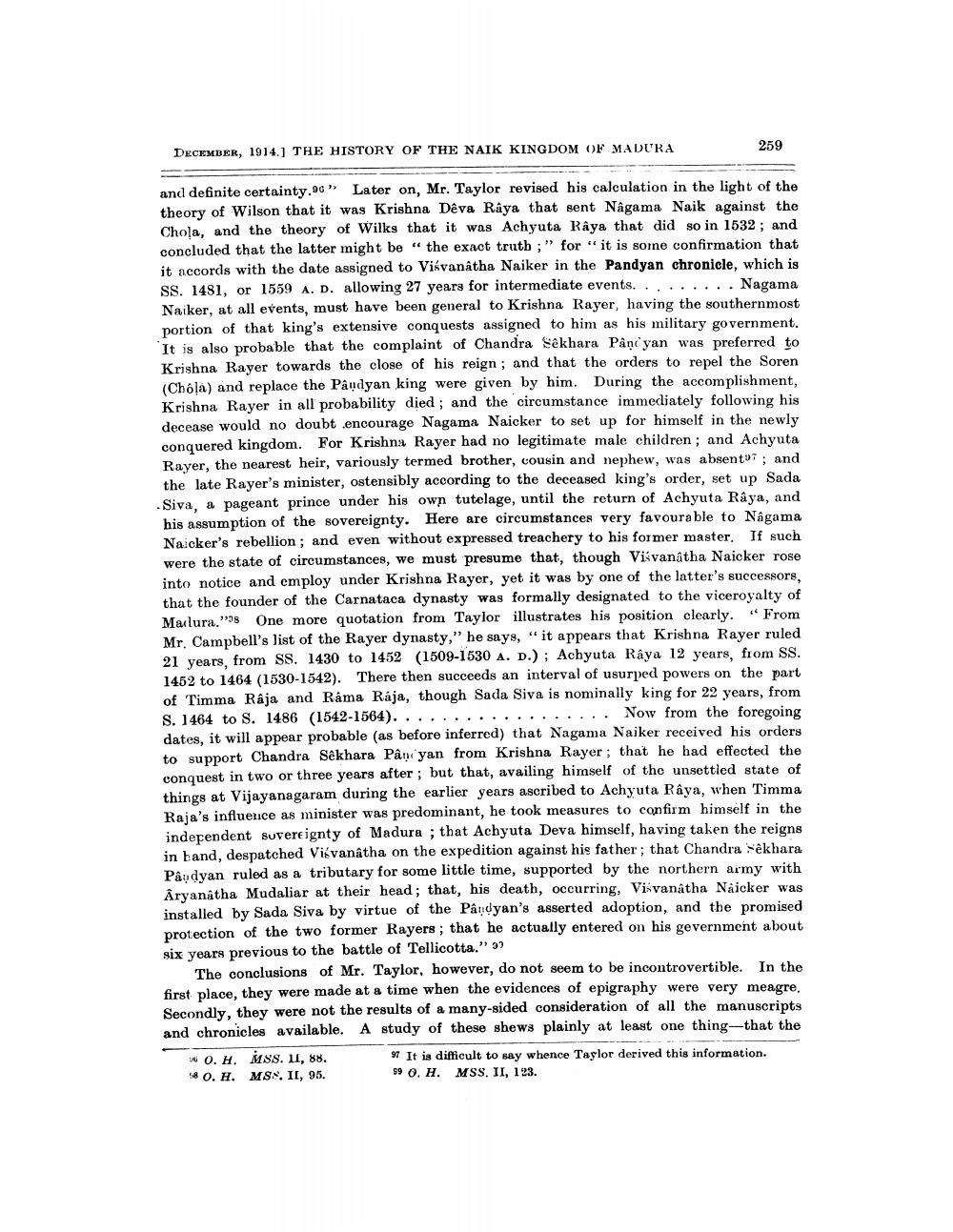________________
DECEMBER, 1914.] THE HISTORY OF THE NAIK KINGDOM OF MADURA
259
and definite certainty.90" Later on, Mr. Taylor revised his calculation in the light of the theory of Wilson that it was Krishna Deva Raya that sent Nâgama Naik against the Chola, and the theory of Wilks that it was Achyuta Raya that did so in 1532; and concluded that the latter might be “the exact truth;" for "it is some confirmation that it accords with the date assigned to Visvanatha Naiker in the Pandyan chronicle, which is SS. 1481, or 1559 A. D. allowing 27 years for intermediate events. ........ Nagama Naiker, at all events, must have been general to Krishna Rayer, having the southernmost portion of that king's extensive conquests assigned to him as his military government. It is also probable that the complaint of Chandra Sêkhara Pånd yan was preferred to Krishna Rayer towards the close of his reign; and that the orders to repel the Soren (Chola) and replace the Pandyan king were given by him. During the accomplishment, Krishna Rayer in all probability died; and the circumstance immediately following his decease would no doubt .encourage Nagama Naicker to set up for himself in the newly conquered kingdom. For Krishna Rayer had no legitimate male children; and Achyuta Rayer, the nearest heir, variously termed brother, cousin and nephew, was absent97; and the late Rayer's minister, ostensibly according to the deceased king's order, set up Sada Siva, a pageant prince under his own tutelage, until the return of Achyuta Raya, and his assumption of the sovereignty. Here are circumstances very favourable to Nâgama Naicker's rebellion; and even without expressed treachery to his former master. If such were the state of circumstances, we must presume that, though Visvanatha Naicker rose into notice and employ under Krishna Rayer, yet it was by one of the latter's successors, that the founder of the Carnataca dynasty was formally designated to the viceroyalty of Malura."98 One more quotation from Taylor illustrates his position clearly. “From Mr. Campbell's list of the Rayer dynasty," he says, "it appears that Krishna Rayer ruled 21 years, from SS. 1430 to 1452 (1509-1530 A. D.); Achyuta Raya 12 years, from SS. 1452 to 1464 (1530-1542). There then succeeds an interval of usurped powers on the part of Timma Raja and Rama Raja, though Sada Siva is nominally king for 22 years, from S. 1464 to S. 1486 (1542-1564). ................. Now from the foregoing dates, it will appear probable (as before inferred) that Nagama Naiker received his orders to support Chandra Sêkhara Pân, yan from Krishna Rayer; that he had effected the conquest in two or three years after ; but that, availing himself of the unsettled state of things at Vijayanagaram during the earlier years ascribed to Achyuta Raya, when Timma Raja's influence as minister was predominant, he took measures to confirm himself in the independent suvereignty of Madura ; that Achyuta Deva himself, having taken the reigns in band, despatched Visvanatha on the expedition against his father; that Chandrasekhara Paudyan ruled as a tributary for some little time, supported by the northern army with Aryanatha Mudaliar at their head; that, his death, occurring, Visvanatha Naicker was installed by Sada Siva by virtue of the Pandyan's asserted adoption, and the promised protection of the two former Rayers; that he actually entered on his gevernment about six years previous to the battle of Tellicotta." 9)
The conclusions of Mr. Taylor, however, do not seem to be incontrovertible. In the first place, they were made at a time when the evidences of epigraphy were very meagre. Secondly, they were not the results of a many-sided consideration of all the manuscripts and chronicles available. A study of these shews plainly at least one thing—that the 0. H. MSS. U, 88.
97 It is difficult to say whence Taylor derived this information. 58 O. H. MSS. II, 95.
99 O. H. MSS. II, 123.




